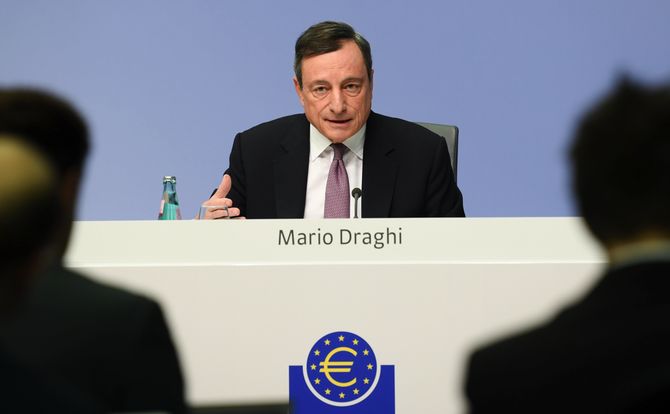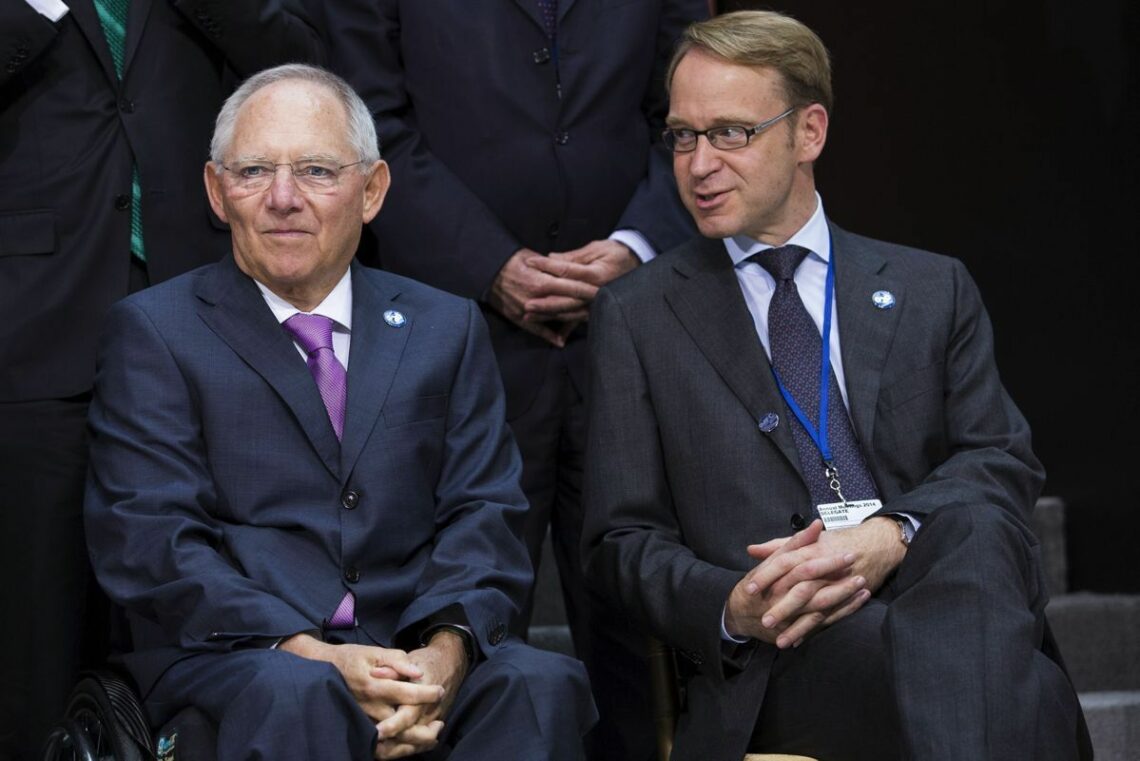The consequences of prolonged low interest rates in Europe
Monetary policymakers are becoming preoccupied with the risks of persistently low interest rates to Europe’s still fragile economic recovery. Ultra-easy credit is creating growing economic distortions and asset bubbles, while reviving volatility and risk in financial markets.

In a nutshell
- Nine years of cheap credit have created growing market distortions in the euro area
- “Zombie” corporations, income-starved households, and shaky banks are the result
- To avoid another financial crisis, policymakers must normalize interest rates
- Yet exiting QE too quickly could kill the euro area’s recovery and trigger a crisis, too
Over the past few months, several of Europe’s top central banks have repeatedly emphasized the risks of persistently low interest rates for the recent, still fragile, economic recovery in the European Union countries. While Germany’s Bundesbank points to the emergence of new bubbles in parts of the capital and real estate markets, fueled by an increase in undue risk-taking by market participants, Denmark’s Nationalbank is preoccupied more specifically with the easing of lending conditions by commercial banks. The latter find themselves tempted to grant loans to potentially vulnerable customers as a way of shoring up profits eroded by prolonged low interest rates.
The high and continuously increasing indebtedness not only of European households and corporates, but of countries as well, has become a serious cause of concern. It is telling that the Swiss-based Bank for International Settlements, known as the central bankers’ central bank, has recently warned of the growing risk of a “debt-trap” if interest rates stay near zero.
How to interpret these warnings in the light of Europe’s current macroeconomic evolution? They reveal much about the long-term effectiveness of postcrisis monetary policy in stimulating investment and growth, and show what happens if interest rates are kept low for too long. They can also provide important clues about a possible impending normalization of interest rates – a major concern for financial markets. Investors want to know whether rates are likely to go up soon and, if so, how fast and by how much.
Consequences intended and unintended
In a way, these central banks are calling into question their own ultra-easy monetary policies of the past nine years, which consisted in cutting short-term interest rates to near zero in the euro area and, for a long time, even lower than zero, before exerting additional downward pressure on long-term rates through large-scale purchases of government bonds – a process known as “quantitative easing,” or QE.
What their current warnings reflect above all is a trade-off they must face while conducting monetary policy in an increasingly global world: the trade-off between short-term intended effects and long-term unintended consequences. In 2008-2009, when money markets had become dysfunctional and a real danger of economic collapse was looming worldwide, there had been a clear need for sharply lower interest rates and the supply of significant liquidity to financially distressed economies.
New pockets of vulnerability have appeared within the world economic and financial system.
Back then, an expansionary monetary policy was seen as an indispensable tool for maintaining price stability in the face of insufficient aggregate demand, drastically rising unemployment and downward inflationary pressure. Low interest rates appeared necessary to unclog the bank lending channel, encourage business investment and, ultimately, promote growth. But in the present circumstances of improving macroeconomic and financial conditions in Europe, is aggressive monetary easing still appropriate? The answer of Bundesbank President Jens Weidmann is a clear no: the era of cheap money should come to an end as soon as possible.
In particular, the European Central Bank’s ambitious QE program – which has pumped over 2 trillion euros into the EU economy since its inception in March 2015 –is increasingly the object of criticism, even among central bankers. More than ever, the ability of ultra-loose monetary policy to reinvigorate long-term growth is being debated. It is undeniable that policy stimulus has started bearing fruit – indeed, with expansion of 2.2 percent in 2017, and forecasts of 2.1 percent in 2018 and 1.9 percent in 2019, the eurozone economy is registering its highest growth rates in more than 10 years. This recovery is being accompanied by solid employment gains, a pickup in trade growth and a moderate upturn in investment, according to the latest OECD Economic Outlook.
But even so, new pockets of vulnerability have appeared within the world economic and financial system, including in Europe, such as speculative asset bubbles about to burst. This suggests that prolonging ultra-low or negative interest rates may become counterproductive.
Zombies and repression
Expansionary monetary policy appears to be producing market distortions that adversely affect expected economic outcomes. Poorly allocated business investments (“malinvestment”), induced by exceptionally low borrowing costs, are one example. As central banks usurp the normal role of economic fundamentals by unilaterally determining key interest rates, wrong or misleading price signals are sent to investors, eventually exposing them to grave risks when interest rates go up again.
Several recent OECD studies argue that there have been too many mistaken investments, especially in Europe, which will weigh on growth in the coming years. In particular, the “zombification” of increasing large parts of the eurozone’s corporate sector is denounced – or more precisely, the misallocation of resources induced by the proliferation of low productivity firms. These so-called “corporate zombies” would typically be weeded out in a normal competitive market, but flourish dangerously in a world of cheap credit.
Keeping interest rates artificially low through public intervention amounts to an annual tax on savers.
The current high levels of “financial repression” are another facet of policy-induced market distortion. In economic theory, the term is used to describe attempts by governments to channel funds to themselves that would otherwise go to the economy. Keeping interest rates artificially low through public intervention amounts to an annual tax on savers and a transfer of benefits from lenders to borrowers. After almost a decade of ultra-loose monetary policy, the impact of forgone interest income on the EU private sector is substantial. Studies show that financial repression entails high costs, especially for long-term investors, lowering their ability to put money back into the real economy and support growth.
Financial repression concerns Europe’s households, too, depriving them of income from their savings. Paradoxically, this has not kept them from saving. Worried about the long-term viability of pension systems, Europeans save more for their retirement today than a decade ago, which confirms that savings behavior is not determined by interest rates alone. Increasing gloom about the future, a lack of confidence in public institutions, and aging populations help create what American economist Larry Summers calls a “chronic excess of saving over investment,” which he regards as the “essence of secular stagnation.” Saving more implies spending less, curbing aggregate demand, pulling down inflation and interest rates, and weakening the economy’s long-term growth potential.
Building imbalances
According to the secular stagnation literature, if noteworthy levels of growth are nonetheless achieved in a low interest rate environment, as is the case in Europe today, this is largely attributable, to quote Summers again, to “dangerous levels of borrowing that translate excess savings into unsustainable levels of investment” – real estate bubbles, for instance.
On the other side of the credit channel, financial institutions are also facing difficulties in adapting their business models to a persistent low interest rate environment. Many banks across Europe are heavily burdened with bad loans. This not only limits their ability to provide credit to the economy; it puts the entire banking system at risk.

At the same time, volatility and risk are picking up in financial markets. Hence, some of the imbalances that had led to the 2008 crisis are building up again – except that in the meantime, governments have accumulated massive debts. Today, some EU countries are far more indebted than they were shortly after the 2008 crisis. Not only Greece is drowning in debt. Fifteen EU member countries have debts larger than the 60 percent of GDP limit set out in the Maastricht Treaty; in eight countries, the debt is more than 100 percent of annual output.
One of the downsides of a long-term expansionary monetary policy is precisely that it reduces the urgency of reducing excessive public debt. In a way, it even adds to the problem by creating disincentives to fiscal discipline. With sustained low interest rates, governments feel no pressure to improve their finances; negative interest rates encourage them to borrow even more.
Splintered policies
Likewise, focusing on a prolonged monetary stimulus distracts policymakers from their real economic challenge, which is to help raise productivity and create jobs through structural reforms, especially of the labor market. For decades, growth in total factor productivity has been slowing in the euro area, even as the population stopped growing and inexorably aged.
This latter phenomenon will have a devastating impact on public finances in many EU countries, resulting in too much debt and too little growth for decades to come. Even the ECB, in its latest Financial Stability Review, notes with concern that “growing fragmentation” of Europe’s “political landscape” could result in “a further slowdown of fiscal and structural reform efforts.”
It could be asked to what extent the ECB itself has contributed to this political fragmentation – deliberately or unintentionally. The question is not farfetched. Last summer, the German Federal Constitutional Court (Bundesverfassungsgericht) discussed whether the ECB had not, in fact, engaged in a prohibited monetary financing of the fiscal deficits of certain member states to the detriment of others, resulting in a significant redistribution from the euro area’s less indebted north to the highly indebted south. If this were true, the ECB’s expanded asset purchase program would violate Germany’s basic law, and the bank would have manifestly exceeded its monetary policy mandate. The case has now been referred to the EU Court of Justice for a preliminary ruling.
Minsky moment
In his parting speech as Germany’s finance minister, Wolfgang Schauble raised concerns that bad loans, along with growing levels of global private and public debt, may push the world into another financial crisis. Are we approaching the next “Minsky moment”?
The concept came up again during the 2008-2009 financial crisis to designate situations where asset bubbles burst and “Ponzi financing” (to use Minsky’s term) abruptly stops. As borrowers default and debt goes bad, the financial system collapses. This happened 10 years ago. Could it happen again?
Conditions will become even more challenging as soon as interest rates start to go up.
The answer might well be yes if central banks fail to consider in a timely fashion the various headwinds that could weaken the effectiveness of their policies – headwinds that, as the current situation shows, blow strongly when interest rates are low. This makes the timing and speed of withdrawal from stimulus policies the key dilemma for Europe’s central banks in 2018.
But conditions will become even more challenging as soon as interest rates, freed from the yoke of QE policies, start to go up. Over-indebted households, businesses and governments will be confronted with a new, unpleasant reality. The most vulnerable – including governments – could soon become insolvent, potentially plunging the entire EU into an unprecedented sovereign debt crisis. This scenario is plausible enough to scare the usually sanguine ECB, as shown by this excerpt from its November 2017 Financial Stability Report:
Looking ahead, higher long term interest rates, waning structural and fiscal reform efforts, as well as pockets of risks surrounding the sovereign-bank nexus in some countries may challenge public finances. The materialization of any of these vulnerabilities – in isolation or in combination – may trigger repricing of sovereign debt and reignite concerns regarding public debt sustainability.
Beyond QE
The ECB is facing a dilemma: withdrawing its QE program too abruptly could abort the economic recovery and precipitate the EU into the dreaded sovereign debt trap; exiting too late might be even worse, as it could overheat the economy, inflate incipient bubbles, magnify the debt overhang and set off a crisis with even fewer ways out, since the euro area’s economy is now more vulnerable to financial and real shocks.
At all costs, the ECB wants to avoid a brutal rise in interest rates. Such a scenario would have nightmarish implications for a range of economic actors – insurance companies and pension funds top the list – as well as for over-indebted governments. No wonder policymakers in Frankfurt are walking on eggshells. Delicate management of the transition from ultra-low interest rates appears indispensable to avoid the massive risks associated with an abrupt policy move.
Instead of attenuating the euro area’s vulnerabilities, the ECB’s accommodative policy has made them more acute.
After months of hesitation, the ECB finally decided to slow down its QE program by halving bond-buying from 60 billion euros a month to 30 billion euros. The taper started in January 2018 and will end, according to official announcements, in September 2018 or “beyond.” The ECB’s money tap is likely to remain open until the target of price stability or, more precisely, an inflation rate of just below 2 percent has been achieved. This is far from being the case right now.
Only “well past” a complete withdrawal of QE will the ECB be ready to consider normalizing interest rates, the bank said in its October 2017 policy statement. What exactly it means by “well past” is not clear. One can expect that in the short term, eurozone interest rates will remain at their historic lows. For months, ECB President Mario Draghi has repeatedly asked market participants to be patient and not expect interest rates to increase until 2019 “at the earliest.”
But in the long run, the ECB’s accommodative monetary policy system is unsustainable. Indeed, it has already reached its limits: instead of attenuating the economic vulnerabilities of the euro area, it has made them more acute, laying the groundwork for future economic stagnation instead of growth – and this despite the longest-lasting favorable financial conditions of all time. Like a bodybuilder on steroids (to cite an unpleasant remark made to Mr. Draghi by a Dutch eurodeputy), Europe’s economy has become addicted to a steady flow of ultra-easy money. Whatever the scenario, withdrawal will be painful.
As things stand now, it is difficult to imagine how Europe will be able to avoid another systemic crisis in the next decade.








